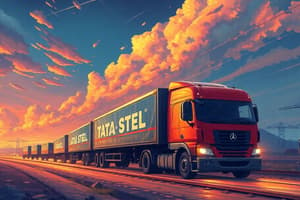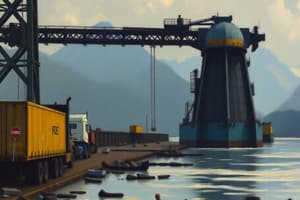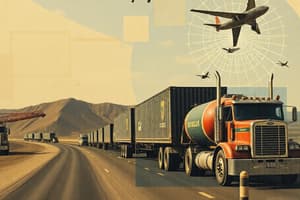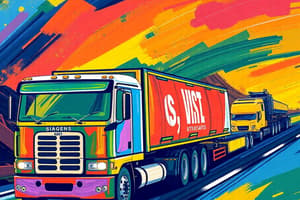Podcast
Questions and Answers
What is a Bill of Lading primarily used for?
What is a Bill of Lading primarily used for?
- To track delivery times
- To outline shipping routes
- To show goods, their quantity, and destination (correct)
- To serve as a purchase order
Which Incoterm indicates that the seller has fulfilled their obligation once goods are ready for pickup at their premises?
Which Incoterm indicates that the seller has fulfilled their obligation once goods are ready for pickup at their premises?
- FCA
- EXW (correct)
- DAP
- CIP
What does the term CPT stand for in Incoterms?
What does the term CPT stand for in Incoterms?
- Carriage Pricing Terms
- Carriage Paid To (correct)
- Customs Paid To
- Cost Paid Transport
In the term CIP, what additional obligation does the seller have compared to CPT?
In the term CIP, what additional obligation does the seller have compared to CPT?
Which Incoterm requires the seller to deliver goods at an identified terminal and unload them for the buyer?
Which Incoterm requires the seller to deliver goods at an identified terminal and unload them for the buyer?
What does DDP stand for in the context of Incoterms?
What does DDP stand for in the context of Incoterms?
What is the purpose of cross docking in a business?
What is the purpose of cross docking in a business?
Which term describes the seller delivering goods to a carrier specified by the buyer on the seller's premises?
Which term describes the seller delivering goods to a carrier specified by the buyer on the seller's premises?
What is one of the main goals of Just-in-time manufacturing?
What is one of the main goals of Just-in-time manufacturing?
Which step is NOT part of the order fulfillment process?
Which step is NOT part of the order fulfillment process?
What does FIFO stand for in supply chain management?
What does FIFO stand for in supply chain management?
What is the purpose of back ordering?
What is the purpose of back ordering?
Which of the following best describes LIFO?
Which of the following best describes LIFO?
What is included in the landed cost of an item?
What is included in the landed cost of an item?
What is a primary feature of the Toyota Production System?
What is a primary feature of the Toyota Production System?
Which of the following does NOT characterize supply chain management?
Which of the following does NOT characterize supply chain management?
Flashcards
Supply Chain Management
Supply Chain Management
A network connecting a company and its suppliers to produce and distribute a product to the end-user. It involves different activities, people, entities, information, and resources.
Order Fulfillment
Order Fulfillment
The process of receiving orders, storing goods, processing orders, shipping, and handling returns to satisfy customer needs.
Just-in-Time Manufacturing
Just-in-Time Manufacturing
A manufacturing approach to minimize inventory by producing goods only when needed, reducing costs and waste.
FIFO
FIFO
Signup and view all the flashcards
LIFO
LIFO
Signup and view all the flashcards
Landed Cost
Landed Cost
Signup and view all the flashcards
Back Ordering
Back Ordering
Signup and view all the flashcards
Bill of Lading
Bill of Lading
Signup and view all the flashcards
Cross Docking
Cross Docking
Signup and view all the flashcards
Incoterms
Incoterms
Signup and view all the flashcards
EXW (Ex Works)
EXW (Ex Works)
Signup and view all the flashcards
FCA (Free Carrier)
FCA (Free Carrier)
Signup and view all the flashcards
CPT (Carriage Paid To)
CPT (Carriage Paid To)
Signup and view all the flashcards
CIP (Carriage and Insurance Paid To)
CIP (Carriage and Insurance Paid To)
Signup and view all the flashcards
DAT (Delivered At Terminal)
DAT (Delivered At Terminal)
Signup and view all the flashcards
DAP (Delivered at Place)
DAP (Delivered at Place)
Signup and view all the flashcards
DDP (Delivered Duty Paid)
DDP (Delivered Duty Paid)
Signup and view all the flashcards
FAS (Free Alongside Ship)
FAS (Free Alongside Ship)
Signup and view all the flashcards
Study Notes
SAKSHAM: IL6 Webinar for Logistics - Supply Chain Management
- Tata Steel webinar on supply chain management
- Supply chain management is a network between a company and its suppliers to produce and distribute a specific product to the final customer
- It includes various activities and involves different people and entities, and information and resources
Supply Chain Management Definition
- Effective management of flow of information, material, and funds from supplier's supplier to final consumer
Supply Chain Diagram
- Diagram depicts the flow of information, material, and funds from suppliers' suppliers to the final consumer
- Entities in the diagram include Supplier's Supplier, Supplier, Manufacturer, Wholesaler, Retailer, Consumer
Tata Steel Supply Chain - Work Flow Diagram
- Detailed flow diagram outlining the work flow of supply chain at Tata Steel (TSM)
- Process steps include procurement, receiving raw materials, processing at plant, vehicle placement, packaging, placement of transport, loading of materials, QA check, system documentation, and payment
Supply Chain Processes - Push/Pull View
- Supply chain processes fall into two categories:
- Pull: execution initiated in response to a customer order (reactive)
- Push: execution initiated in anticipation of a customer order (speculative)
- Push/pull boundary separates push processes from pull processes
Scope of Supply Chain in a Firm
- Includes communication and information flow, internal supply chain, external supply chain, and CRM, SCM and SRM
Key Activity in Macro Process
- Lists CRM, SCM and SRM as key activities in the macro process under supply chain management
Order Generation and Fulfillment
- Five steps in the order fulfillment process:
- Receiving inventory shipments
- Inventory storage
- Order processing
- Shipping
- Returns processing
Important Concepts in Supply Chain
- Just-in-Time (JIT): A management strategy aligning raw-material orders with production schedules, also known as Toyota Production System (TPS)
- Vendor Managed Inventory (VMI): Increases efficiency, decreases waste, reduces inventory costs, and requires producers to accurately forecast demand, and involves a supplier managing the inventory for the customer
- Kanban: An inventory control system used in just-in-time manufacturing, used to track and order parts and materials
- FIFO & LIFO: Cost lot tracking methods where items are valued and sold in the order they purchased (FIFO) or most recent purchase first (LIFO)
- Landed Cost: The total cost of ownership of an item, including cost price, shipping charges, customs duties, taxes, and other charges
- Back Ordering: Placing a purchase order for a product temporarily out of stock in response to high demand or a spike in demand
- Bill of Lading: A shipping document showing goods' type, quantity, and destination address, acting as a legal receipt
- Cross Docking: A method to ship goods from vendors to customers with minimal storage time
Different Incoterms in Supply Chain
- EXW, FCA, FAS, FOB, CFR, DAT, DAP, DDP in a diagram describing international recognized rules defining responsibilities of sellers and buyers in export transactions
Different Types of Logistics
- Diagram illustrating different types of logistics (1PL, 2PL, 3PL, 4PL, and 5PL) and activities involved in each model
Studying That Suits You
Use AI to generate personalized quizzes and flashcards to suit your learning preferences.




